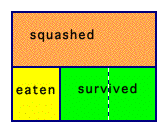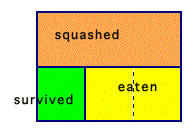
You might think that this is a simple subtraction problem: 1/2 - 1/3 = 1/6, but if you draw a picture, your answers don't match:

So which is right? Well, the picture shows just what happened, so it has to be right, and 1/3 of the plant's survived. What would the picture look like if the answer was 1/2 - 1/3? Well, it would look like this:

This second picture shows that the cat ate 1/3 of the plants, not 1/3 of the plants that were left after some got squashed.
 | Lori planted some seedlings. Her little brother was playing, and squashed half of the seedlings (they did not survive). Then, her cat ate 1/3 of the seedlings that were left. How many of her seedlings survived? 1/3 of the plants that were not squashed were eaten: 1/2 -(1/3 of 1/2) = 1/2 - (1/3)x(1/2) Answer 2/6 = 1/3 of the plants survived The eaten plants are 1/3 of 1/2 of the plants (the whole for 1/3 is 1/2 of the plants) |
 | Lori planted some seedlings. Her little brother was playing, and squashed half of the seedlings (they did not survive). Then, her cat ate another 1/3 of the original plot of seedlings. How many of her seedlings survived? 1/3 of the total plants were eaten 1/2 - 1/3 Answer: 1/6 of the plants survived. The eaten plants are 1/3 of the total plants (the whole for 1/3 is all of the plants) |
It's a subtle change, but an important one: you are taking 1/3 of different things in the two problems: in the first problem, you are taking 1/3 of the seedlings that are left after 1/2 were squashed, and in the second problem you are taking 1/3 of the total number of seedlings.